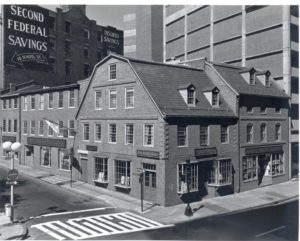
23 Nov 2022 Historic choices at the Old Corner Bookstore
Historic Boston Inc. (HBI) is planning much-needed updates to the Old Corner Bookstore complex to provide elevator access to the upper floors, improve its carbon footprint, and ensure its climate resiliency for decades to come. As part of that planning process, HBI will also revisit its public presentation, signage standards, and historic interpretation.
But which era of the building’s history will we tell? This is a question HBI will be grappling with over the next few months. Many photos exist that show the Old Corner Bookstore’s evolution through the 19th and early 20th century, which could inspire some modifications to the complex as HBI also evaluates how best to share the Old Corner Bookstore’s fascinating history. The building is made up of four historic buildings, ranging in dates from 1718 to circa 1820. Each would have been built to the architectural style of its time.
When Historic Boston’s founders acquired the buildings in 1960, they accomplished an impressive first goal – preventing the assemblage of 18th and early 19th century buildings from being demolished in favor of a parking garage. At that time, it is likely that many, if not most, passersby knew nothing of the building’s age, evolution over time, and historic importance. In 1960, billboards advertising a bank and fifteen-cent pizza slices covered much of the Old Corner’s dreary façade, including upper story windows. The first floor 1950s style storefronts with awnings could have been any building, anywhere, and an array of signage types were scattered all over the buildings, which suggested no thought had been given to the buildings’ overall presentation.

The Old Corner Bookstore, circa 1960
HBI’s acquisition of the Old Corner Bookstore complex came at a time when the importance of historic preservation was beginning to be acknowledged on a national level, rather than the more grassroots efforts that previously existed. Most notably, the passage of the National Historic Preservation Act of 1966 gave credibility to the movement, clarifying goals and establishing standards for saving the country’s most architecturally and historically significant buildings. However, while standards offer guidance, with any preservation project there are many, many decisions to be made.
In 1960, the Old Corner Bookstore was already 242 years old and had had multiple uses and appearances, beginning as a private residence over an apothecary shop, and over time housing many businesses and shops on both the street level and upper stories, with changes to the facades that reflected the times and uses. As far back as 1795, the complex housed several bookstores and publishers, but is best known for as headquarters of Ticknor & Fields, renowned publishers of 19th century American authors Emerson, Hawthorne, Longfellow, Thoreau, Twain, and Stowe, among many others.
HBI’s founders were charged with answering a similar question to the one we’re grappling with today: given its rich history, how should the Old Corner appear, and how should its story best be told? While the best-known occupant is the mid-19th century Ticknor & Fields, it is also celebrated for its architecture and for being one of the oldest buildings in Boston. The resulting renovation is an amalgam of a few significant periods. Rippled glass 12 over 12 pane windows in the corner building are evocative of its likely colonial appearance, though the glass is reproduction, not original fabric. The storefront appearances are intended to be more reflective of its mid-19th century, Ticknor & Fields period.

The Old Corner Bookstore, circa 1980
Choosing the story the building should tell, HBI can begin to research how that story should be presented by the building. Perhaps each of the four buildings that make up the corner complex will each have different window treatments, different paint colors, and different brick pointing. Over the coming months HBI will be giving you insight into this process.



